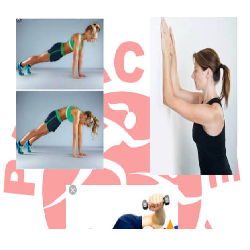
In case if you missed our second series click here
A progressive strengthening program focused on scapular musculature and the rotator cuff should be included.
The scapula provides a stable base so that humeral head can rotate and elevate during functional activity.
Neuromuscular control focused on proximal stability should be focused on prior to addressing distal segment mobility.
Human movements do not happen in isolation, but rather they occur in co-ordination of many joints and muscles in multiple planes.
Scapulothoracic articulation serves an essential bridge between the core musculature and lower extremity to transfer kinetic energy up the chain.
Abnormal scapular kinematics can be caused by pain associated with injury, soft tissue tightness, strength imbalances, and deficiencies in muscle activity.
individuals with rotator cuff pathology and shoulder pain demonstrate decreased strength of the serratus anterior, early activation and hyperactivity of the upper trapezius, and decreased activity and activation of the middle and lower trapezius. So intervention program should focus on activation of lower and middle trapezius and serratus anterior and deactivation of upper trapezius.
A progressive scapular strengthening program should include [restrict] both:
[A]
Open kinetic chain activities; Ex. Wall Clock .
[B]
Closed kinetic chain activities; Ex. Roller + Ext Rot
The ‘Push-up plus” has also been shown to generate greater muscle activation of the serratus anterior.
[C]
Studies have demonstrated that sidelying external rotation produces high EMG activity in both the infraspinatus and teres minor.
The “Thrower’s 10” program is a progressive isotonic strengthening program based on EMG data, addressing rotator cuff strength and scapular stabilization. .
BFR : training is a newer technique that can be employed during this stage and can be used as an adjunct to traditional resistance training.
However, further research is needed to determine the overall efficacy for athletes with rotator cuff injury. .
Don’t miss anything! Turn on Post Notifications
Next Up:
4. Advanced/Late Stage Rehabilitation
5. Future Directions and Conclusions
[/restrict]
Register to read more
Reference :
Weiss et al. 2018. Management of Rotator cuff injury


